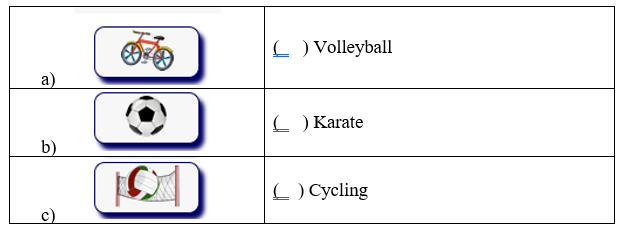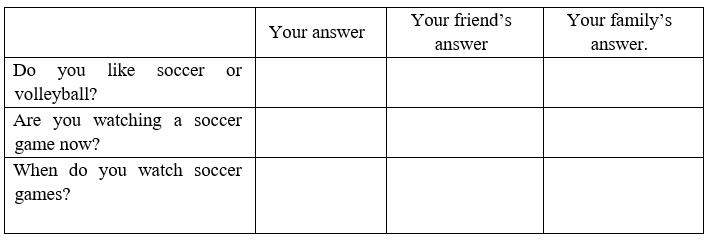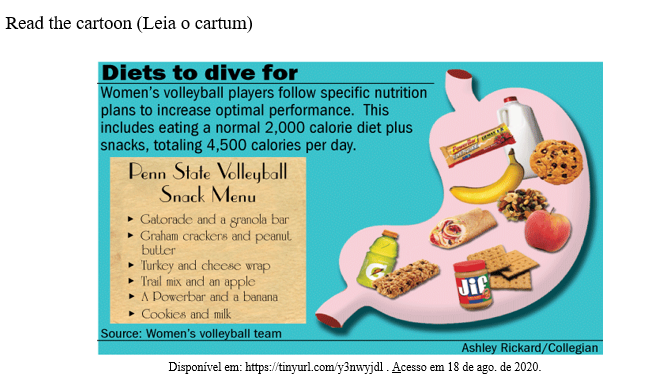AULA 12/2023 – Sports: Simple Present and Present Continuous - 15/08/2023

Classes gramaticais:
NOUN (substantivo): é uma classe de palavras que nomeia seres, objetos, fenômenos, lugares, dentre outros: car, pencil, horse, cat, dog, girl, man, river, etc.
ADJECTIVE (adjetivo): é qualquer palavra usada para descrever alguém ou algo: big, tall, intelligent, easy, difficult, etc.
VERB (verbo): serve para indicar uma ação: to run, to drive, to eat, to study, to visit, to watch, to play, etc.
- Match the items to the correct name of the sport. (Marque as imagens com os nomes corretos dos esportes.)


Disponível em: https://agendaweb.org/exercises/vocabulary/hobbies/sports-match Acesso em 22 de jun. de 2021. (Adaptado)
Now, let’s read a text and do some exercises!
Soccer (also called “football” in most parts of the world outside the US) is the most popular sport in the world.
According to a recent Nielsen’s World Football Report across 18 global markets, over 40 percent of the population describe themselves as soccer fans.
In the US, soccer is still growing and Nielsen estimates that interest in the Major League Soccer has increased by 27 percent since 2012.
But, besides the emotions of joy, triumph and the sheer entertainment of competing, there are so many health benefits of playing soccer.
I play soccer on Sundays as part of my morning exercises.
Disponível em: https://tinyurl.com/y2yebhgj Acesso em 18 de ago. de 2020.

2. Answer these questions according to the text above. (Responda as essas perguntas de acordo com o texto acima.)
a) Is soccer the most popular sport in the world? Why? (O futebol é o esporte mais popular do mundo? Por que?)
b) Who describes as soccer fans? (Quem descreve como fãs de futebol?)
c) Is soccer still growing all over the world? Why? (O futebol ainda está crescendo em todo o mundo? Por que?)
d) Are there so many benefits of playing football? name a few. (Há tantos benefícios de jogar futebol? Cite alguns.
3. Para entendermos os textos, precisamos reconhecer a classe gramatical de cada palavra. Desse modo, identifique a classe gramatical das palavras destacadas nas frases.
a) SOCCER is still growing (…)
b) (…) the most POPULAR sport in the WORLD.
c) I PLAY soccer on Sundays.
4. Answer these questions and then ask your friends and your family. Take notes in the following chart. (Responda essas perguntas e depois pergunte a seus amigos e familiares. Faça as anotações na tabela a seguir.)

5. Pesquise palavras e expressões em língua inglesa usadas no SOCCER WORLD na sociedade brasileira.

6. Answer these questions with information from the cartoon. (Responda a essas perguntas com as informações do cartum.)
a) Why do women’s volleyball players follow specific nutrition plans? (Por que as jogadoras de voleibol feminino seguem planos nutricionais específicos?)
b) What are some fruits in the Penn State Volleyball Snack Menu? (Quais são algumas frutas no menu de lanches de vôlei da Penn State?)
7. Make questions according to the answers below using the simple present or the present continuous. (Elabore perguntas de acordo com as respostas abaixo usando o presente simples ou o presente contínuo.)
a) ____________________________________________________________________?
My favorite sport is volleyball
b) ___________________________________________________________________?
Yes, he is. He is a great swimmer.
c) ____________________________________________________________________?
My friend plays soccer on Sundays.
d) ____________________________________________________________________?
Yes, I do. I ride a bike on Saturday.
Now, let’s read an interview.
Interviewer: Good morning, Lara.
Lara: Hi.
Interviewer: Can you tell me about a typical day in your life for the school magazine?
Lara: Yeah, sure.
Interviewer: So, what time do you get up?
Lara: Oh, I get up very early. I get up every day at 5 o’clock and go to the pool. Then I swim from 6 o’clock to 8 o’clock.
Interviewer: You get up at 5 o’clock! Wow, that’s early!
Lara: Yeah. Then at 8 o’clock I have a shower, I get dressed and I have breakfast. I have a big breakfast: cereals, toast, coffee and milk.
Interviewer: What do you do after breakfast?
Lara: I do my homework.
Interviewer: When do you have lunch?
Lara: I have lunch at about 11:30 with my family.
Interviewer: When do you go to school?
Lara: I go to school at 1 o’clock. I have classes from 1 o’clock to 5 o’clock.
Interviewer: What do you do after classes?
Lara: Sometimes I go to the gym and sometimes I meet my friends at a café.
Interviewer: What time do you have dinner?
Lara: I have dinner at 7 o’clock, then I watch TV or go online, and I usually go to bed at 10 o’clock.
Interviewer: Thanks, Lara. That’s a busy day!
Disponível em: https://brainly.com.br/tarefa/47398764 acesso em 09 de junho de 2022.
Tradução
Agora, vamos ler uma entrevista.
Entrevistador: Bom dia, Lara.
Lara: Oi.
Entrevistador: Você pode me contar sobre um dia típico da sua vida para a revista da escola?
Laura: Sim, claro.
Entrevistador: Então que horas você acorda?
Lara: Ah, eu acordo muito cedo. Acordo todos os dias às 5 da manhã e vou para a piscina.
Então eu nado das 6h às 8h.
Entrevistador: Você acorda às 5 horas! Nossa, é cedo!
Lara: Sim. Então às 8 horas eu tomo banho, me visto e tomo café da manhã. Eu tomo um
grande café da manhã: cereais, torradas, café e leite.
Entrevistador: O que você faz depois do café da manhã?
Lara: Eu faço minha lição de casa.
Entrevistador: Quando você almoça?
Lara: Eu almoço por volta das 23h30 com minha família.
Entrevistador: Quando você vai para a escola?
Lara: Eu vou para à escola às 13h. Tenho aulas das 13h às 17h.
Entrevistador: O que você faz depois da escola?
Lara: Às vezes vou à academia e às vezes encontro meus amigos em um café.
Entrevistador: Que horas você janta?
Lara: Eu janto às 7 horas, depois assisto TV ou fico online, e costumo ir para a cama às 10
horas.
Entrevistador: Obrigado, Lara. Este é um dia inteiro!
8. Match the columns as per the interview information above. (Combine as colunas de acordo com as informações da entrevista acima.)

9. Mark an X TRUE or FALSE according to the interview. (Marque um X no verdadeiro ou falso de acordo com a entrevista.)

10.Write the words are on the board, filling in the blanks, making the sentence grammatically correct. (Escreva as palavras que estão no quadro, preenchendo os espaços em branco, tornando a frase gramaticalmente correta.)
